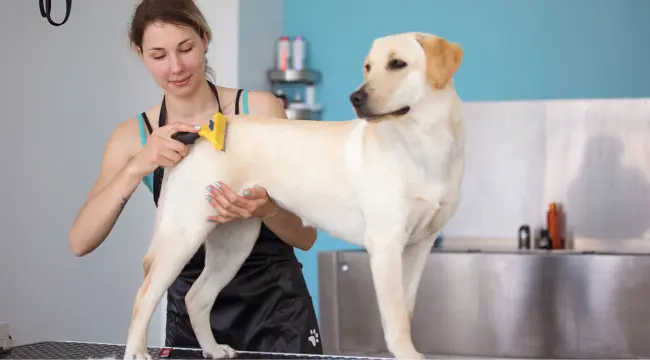
If you love animals, then working with dogs might be right up your alley. Grooming dogs is a tough but rewarding job. Dog groomers work long hours, and are occasionally bitten, however, they help dogs live healthier and happier lives. If this sounds appealing, you may be wondering how to become a dog groomer.
Don’t be fooled by the quick-fix programs. There is a lot to know about grooming dogs that takes extensive hands-on training and a lot of knowledge about the different breeds. You also need to know how to deal with different dog personalities and quite possibly dogs with disabilities. Here are a few tips on how to become a bonafide, certified dog groomer and the journey you will embark on to get there.
Steps to Becoming a Dog Groomer
There’s no “one way” to learn how to become a dog groomer but the following steps are highly recommended to be successful as a business owner as well as in your craft.
Research and choose a dog grooming school with hands-on training
If you are interested in becoming a dog groomer, the first step is to research and choose a dog grooming school or apprenticeship program. While no formal education is required to become a dog groomer, completing a dog grooming program or apprenticeship is highly recommended.
These programs typically take about a year to complete and provide hands-on experience in grooming techniques and safety procedures. Hound Therapy in Plano, TX is one of the few programs that cover the full range of pet grooming PLUS the business aspect of running a grooming salon or mobile service.
Completing a Dog Grooming Program or Apprenticeship
It is also beneficial to have previous experience in animal or pet services, which can be gained through volunteering or working part-time in a related field. Another option is to do an apprenticeship with an experienced groomer, where you would shadow them and learn the craft.
Obtaining Certification or Licensing
Once you have completed a dog grooming program or apprenticeship, the next step is to obtain certification or licensing. Certification programs, such as those offered by the National Dog Groomers Association of America, require attending workshops, demonstrating practical ability, and passing an exam to become a Certified Dog Groomer.
Some states also require pet groomers to hold a pet care center license to operate a pet grooming business. Earning your license is a state-regulated process, so it is important to research the requirements in your state.
After completing a dog grooming program or apprenticeship and obtaining certification or licensing, you can begin your career as a dog groomer. Many groomers see success working independently, either in their salon or as a mobile groomer.
As a dog groomer, you will be responsible for the health and well-being of the canines you groom. It is important to continue learning and staying up-to-date on grooming techniques and safety procedures to provide the best care for your furry clients.
Learning and Developing Dog Grooming Skills
The skills you acquire will set the stage for a rewarding career. Failing to go the full distance in developing your skill set will spell disaster. Here are a few essentials you will undoubtedly need.
Understanding Dog Breeds and Coat Types
Becoming a dog groomer requires a deep understanding of dog breeds and coat types. Each breed has its unique coat, which requires specific grooming techniques and tools. Therefore, it is essential to have a good knowledge of dog breeds and coat types to provide the best grooming services.
Aspiring dog groomers can learn about different breeds and coat types by attending grooming schools or workshops. Additionally, the AKC Master Groomer certification evaluates proficiency in four different coat types, making it a valuable certification for experienced groomers. By gaining knowledge about dog breeds and coat types, aspiring dog groomers can provide better grooming services and ensure the well-being of their furry clients.
Learning Basic Grooming Techniques
To become a dog groomer, it is essential to learn basic grooming techniques. Professional grooming courses typically start with the basics, such as bathing, brushing, and nail trimming, and then progress to more advanced techniques.
Aspiring dog groomers can gain practical experience by working as a bather or assistant in a grooming salon. This hands-on experience allows them to develop their skills and learn from experienced groomers. With time and practice, they can master basic grooming techniques and move on to more advanced grooming services.
Advanced Grooming Techniques and Specialized Services
Advanced grooming techniques and specialized services are essential for dog groomers who want to provide top-notch services to their clients. For example, some breeds require specialized haircuts, such as the poodle cut, which requires advanced scissoring techniques. Specialized services, such as teeth cleaning and ear cleaning, can also be offered to clients.
Aspiring dog groomers can take advanced courses to learn these specialized techniques and services. Additionally, they can obtain certifications to showcase their skills and attract more clients. By continually developing their skills and knowledge, dog groomers can provide high-quality services and build a successful career in this field.
Overview of Dog Grooming as a Profession
Dog grooming is an important profession that involves taking care of dogs’ hygiene and appearance. Grooming is essential for maintaining the overall health and well-being of dogs and can help prevent various health problems. As a dog groomer, you will be responsible for bathing, brushing, and trimming dogs’ hair, as well as cleaning their ears and teeth. Additionally, grooming can help identify any potential health issues, such as skin irritations or infections, which can be addressed early on.
Different Types of Dog Grooming Services
There are different types of dog grooming services, including bathing, haircuts, nail trimming, and ear cleaning. Some groomers may offer additional services such as teeth cleaning, flea and tick treatments, and anal gland expression. As a dog groomer, it is important to know different dog breeds and their specific grooming needs. Moreover, dog groomers can choose to work in various settings such as pet salons, mobile grooming vans, or even start their grooming businesses.
Skills and Qualifications Needed to Become a Dog Groomer
To become a dog groomer, certain skills and qualifications are needed. While there are no legal requirements for dog groomers, it is important to have good communication skills, be organized and meticulous, and have a love for animals.
Additionally, it is recommended to have some formal training or education in dog grooming, which can be obtained through vocational schools, community colleges, or apprenticeships with experienced groomers. Some states may require a license to operate a grooming facility, but there are no licensing requirements for professional groomers.
Setting Up and Managing a Dog Grooming Business
Starting a dog grooming business requires careful planning and obtaining the necessary permits and licenses. The first step is to create a business plan that outlines the type of services offered, pricing, and target market. It is important to research the licenses, permits, registrations, and insurance required in the specific location where the business will operate.
Creating a Business Plan and Obtaining Necessary Permits and Licenses
In the United States, obtaining licenses and permits is crucial for starting a successful dog grooming business. Once all necessary permits and licenses have been obtained, the legal structure of the business must be determined. This includes registering the business entity, obtaining insurance, and opening a business bank account and credit card. The startup costs for a dog grooming business range from about $3,500 to $10,000, with the main expenses being equipment and a website.
Purchasing Equipment and Supplies
Purchasing equipment and supplies is another important step in setting up a dog grooming business. Essential items include scissors, nail clippers, ear powder, a finishing dryer, a grooming table, a bath, and cages. It is important to invest in high-quality equipment to ensure the safety and comfort of the dogs being groomed.
However, it is possible to get started with surprisingly little equipment. Some states require dog groomers to be licensed by the state, which may include passing an exam and purchasing specific grooming tools and supplies.
Marketing and Building a Clientele
Marketing and building a clientele is crucial for the success of a dog grooming business. Traditional marketing tools such as business cards and brochures can be used to establish the business’s presence. Offering a customer referral program, developing promotional products, contests, and giveaways, and improving the online presence are other effective marketing strategies.
It is also important to continuously practice and improve technical skills to become a more talented groomer. Offering free nail trims to dogs at local shelters or veterinarians can also help showcase skills and attract potential customers. Finally, conducting market research and gathering feedback from current clients can help determine pricing and services offered.
Continuing Education and Professional Development as a Dog Groomer
Continuing education and professional development are essential for anyone looking to become a successful dog groomer. Attending grooming conferences and workshops is a great way to stay up-to-date with the latest industry trends and best practices. These events provide opportunities to learn from experienced professionals and network with other groomers.
Staying Up-to-Date with Industry Trends and Best Practices
Additionally, free online courses and seminars are available to prospective groomers, providing accessible and flexible options for continuing education. By staying informed about industry developments and techniques, groomers can provide the best possible care for their clients’ pets and establish themselves as experts in their field.
Obtaining Advanced Certifications and Credentials
Obtaining advanced certifications and credentials is another important aspect of professional development for dog groomers. Certifications provide a standardized method for obtaining professional recognition and demonstrating knowledge and expertise in the field.
By obtaining advanced certifications and credentials, groomers can differentiate themselves from their competitors and demonstrate their commitment to providing the best possible care for their clients’ pets.
In addition to continuing education and certifications, running a successful dog grooming business also requires a focus on customer experience and effective business management. Building strong relationships with clients and providing exceptional customer service is key to establishing a loyal client base.
Utilizing effective dog grooming software can also help streamline business operations and improve efficiency. By focusing on both the technical and business aspects of dog grooming, groomers can establish themselves as successful professionals in the industry.


